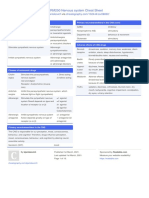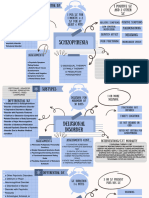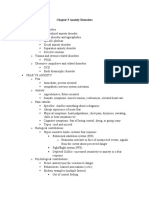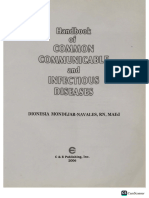Substance Use
Substance Use
Uploaded by
Albert SamanteCopyright:
Available Formats
Substance Use
Substance Use
Uploaded by
Albert SamanteOriginal Description:
Original Title
Copyright
Available Formats
Share this document
Did you find this document useful?
Is this content inappropriate?
Copyright:
Available Formats
Substance Use
Substance Use
Uploaded by
Albert SamanteCopyright:
Available Formats
SUBSTANCE-USE DISORDER
Patterns of symptoms resulting from the use of a substance that a person continues to take despite
experiencing problems as a result
10 CLASSES OF DRUGS THAT CAN CAUSE SUBSTANCE-USE DISORDERS
1. Alcohol 5. Inhalants 9. Stimulants
2. Caffeine 6. Opiods 10. Tobacco
3. Cannabis 7. Sedatives
4. Hallucinogens 8. Hypnotics/Anxiolytics
DSM-5-TR SUBSTANCE-USE DISORDER CRITERIA
1. Taking the substance in larger amounts or 7. Neglecting responsibilities at home, work, or
for longer than intended school because of substance use
2. Trying to cut down or stop using the 8. Continuing to use even when it causes
substance but being unable to relationship problems
3. Experiencing intense cravings or urges to 9. Giving up important or desirable social,
use the substance occupational, and recreational activities due
4. Needing more of the substance to get the to substance
desired effect (tolerance) 10. Using substances in settings that put you at
5. Developing withdrawal symptoms when not risk or in danger
using the substance 11. Continuing to use despite the substance
6. Spending more time getting and using drugs, causing problems to your physical and
and recovering from substance us mental health
SEVERITY OF SUBSTANCE-USE DISORDER
Mild - two or three symptoms point to a mild substance-use disorder
Moderate - four or five symptoms point to a moderate substance-use disorder
Severe - six or more symptoms point to a moderate substance-use disorder
SUBSTANCE-INDUCED DISORDER
Produced by the effects of substance-use, and include intoxication, withdrawal, and other substance or
medication-induced mental disorders
Intoxication - involves substance-induced disorders Withdrawal - involves experiencing physical,
which consist of symptoms people experience when cognitive, and behavioral symptoms due to reducing
they are "high" from drugs or halting substance use
SUBSTANCE-INDUCED MENTAL DISORDERS
1. Substance-Induced Psychotic Disorder - involves experiencing delusions, hallucinations, or both
within one month of using or withdrawing from alcohol, illicit substances, or prescription drugs
2. Substance-Induced Bipolar Disorder - involves experiencing manic or hypomanic symptoms,
depressive symptoms, or both while using or during withdrawal from a substance
3. Substance-Induced Depressive Disorder - refers to a form of depression that can occur after using
drugs, alcohol, or medications.
4. Substance-Induced Anxiety Disorder - involves experiencing anxiety or panic attacks due to using
drugs, medications, or alcohol.
5. Substance-Induced Obsessive-Compulsive Disorder - is marked by the onset of obsessive and
compulsive symptoms caused by substance us
6. Substance-Induced Sleep Disorder - involves insomnia and other sleep problems caused by using
drugs, alcohol, or certain medication.
7. Substance-Induced Sexual Dysfunction - involves experiencing difficulties with sexual arousal, desire,
or performance due to substances and medications.
8. Substance-Induced Delirium - is marked by symptoms of delirium due to intoxication from a
psychoactive substance, including illicit drugs, medications, and alcohol.
9. Substance-Induced Neurocognitive Disorder - involves experiencing mild or major neurocognitive
impairments caused by substance use that persist beyond the intoxication and acute withdrawal
period.
DIAGNOSIS
Substance-use disorders are evaluated by a psychiatrist, psychologist, or licensed counselor
specializing in drug and alcohol addictions
To diagnose a substance use disorder, a healthcare practitioner will evaluate the individual by
completing a physical exam and taking a medical history. They will also ask questions about current and
past substance use, including its frequency, amount, and duration
A health professional may utilize blood or urine tests to assess current drug use
TREATMENT
Behavioral therapies for adults:
Cognitive Behavioral Therapy (CBT) is a Assertive Community Treatment (ACT) is a
type of talk therapy aimed at helping people form of community-based mental health
learn how to cope with difficult situations by care that emphasizes outreach to the
challenging irrational thoughts and changing community and an individualized treatment
behaviors approach
Dialectical Behavior Therapy (DBT) uses Therapeutic Communities (TCs) are a
concepts of mindfulness and acceptance or common form of long-term residential
being aware of and attentive to the current treatment that focuses on helping people
situation and emotional state. DBT also develop new and healthier values, attitudes,
teaches skills that can help control intense and behaviors
emotions, reduce self-destructive behaviors Contingency Management (CM) principles
(e.g. suicide attempts, thoughts, or urges; encourage healthy behaviors by offering
self-harm; and drug use), and improve vouchers or rewards for desired behavior
relationship
Behavioral therapies for children and adolescents:
Brief Strategic Family Therapy (BSFT) therapy targets family interactions thought to maintain or
worsen adolescent substance-use disorders and other co-occurring problem behaviors.
Multidimensional Family Therapy (MDFT) works with the whole family to simultaneously address
multiple and interacting adolescent problem behaviors, such as substance use, mental disorders,
school problems, delinquency, and others.
Multisystemic Therapy (MST) targets key factors associated with serious antisocial behavior in
children and adolescents with substance-use disorders
Medication-Assisted Treatment (MAT) is the practice of using medications to treat substance use disorders,
build long periods of recovery, and prevent overdose. Paired with behavioral therapies, the medications used in
MAT help recovery by:
Limiting withdrawal symptoms that appear when you stop using
Leveling out your brain chemistry
Blocking the effects of alcohol and other drugs
Decreasing the cravings that you have to restart your use
You might also like
- DSM 5 Clinical Cases NotesDocument1 pageDSM 5 Clinical Cases Notestim clayNo ratings yet
- SSRI (Selective Serotonin Reuptake Inhibitor)Document1 pageSSRI (Selective Serotonin Reuptake Inhibitor)Mike EveretteNo ratings yet
- Delirium Pathway - OTLPCM002-3Document1 pageDelirium Pathway - OTLPCM002-3Iftida YatiNo ratings yet
- Most Question That The "Psychiatrist" Would Ask?Document1 pageMost Question That The "Psychiatrist" Would Ask?Chayantorn NimmanwathanaNo ratings yet
- The RX Files: QT Prolongation and Torsades de Pointes: Drugs and Sudden DeathDocument2 pagesThe RX Files: QT Prolongation and Torsades de Pointes: Drugs and Sudden DeathRahul RaiNo ratings yet
- Neurotransmitters: Intellectual FunctionDocument3 pagesNeurotransmitters: Intellectual FunctionMarissa AsimNo ratings yet
- Psychiatry Notes - Depressive DisorderDocument2 pagesPsychiatry Notes - Depressive DisorderLiSenNo ratings yet
- Commonly Abused Drugs ChartDocument2 pagesCommonly Abused Drugs ChartNerpNo ratings yet
- AIMS. Scales-Abnormal-Involuntary-Movement-Scale PDFDocument2 pagesAIMS. Scales-Abnormal-Involuntary-Movement-Scale PDFVictoria RomeroNo ratings yet
- Marijuana THC PresentationDocument21 pagesMarijuana THC PresentationJomariexOrtizNo ratings yet
- Introduction To Psychiatric Nursing: Mercedes A Perez-Millan MSN, ARNPDocument33 pagesIntroduction To Psychiatric Nursing: Mercedes A Perez-Millan MSN, ARNPSachiko Yosores100% (1)
- Antidepressants Comparison Guide Most Commonly Prescribed: Recommend GenericsDocument3 pagesAntidepressants Comparison Guide Most Commonly Prescribed: Recommend GenericsCarina ColtuneacNo ratings yet
- Components of The Mental Status Examination: Psychiatric Assessment With Helen M. Farrell, M.DDocument35 pagesComponents of The Mental Status Examination: Psychiatric Assessment With Helen M. Farrell, M.DJ.C. GarzaNo ratings yet
- Mood DisordersDocument11 pagesMood DisordersPrincessXFaithNo ratings yet
- NR546 Psychopharm Midterm Exam Questions and Answers Latest 2021Document11 pagesNR546 Psychopharm Midterm Exam Questions and Answers Latest 2021iannyaga450No ratings yet
- The Management of Acute DystonicDocument2 pagesThe Management of Acute DystonictaqinosNo ratings yet
- Bipolar Si Des Na IneditDocument17 pagesBipolar Si Des Na IneditWinnie Salazar AriolaNo ratings yet
- PSYCHOPHARMACOLOGYDocument2 pagesPSYCHOPHARMACOLOGYJulia Rae Delos SantosNo ratings yet
- PHARM250 Nervous System Cheat Sheet: by ViaDocument15 pagesPHARM250 Nervous System Cheat Sheet: by ViaThư PhạmNo ratings yet
- 2023-64400-008 BipolarDocument16 pages2023-64400-008 BipolarLuciana OliveiraNo ratings yet
- Murtagh DEPRESSION PsychoeducationDocument1 pageMurtagh DEPRESSION PsychoeducationWaoNo ratings yet
- Neurotransmitters Drugs Agonist Antagonist: AcetylcholineDocument2 pagesNeurotransmitters Drugs Agonist Antagonist: Acetylcholinefariiha100% (1)
- Just Getting The Main RX Names Down : Antidepressants Mood StabilizersDocument1 pageJust Getting The Main RX Names Down : Antidepressants Mood StabilizersCarlos Eduardo LinaresNo ratings yet
- Antidepressant and Antipsychotic Side-Effects and Personalised Prescribing, A Systematic Review and Digital Tool Development. Lancet 2023Document17 pagesAntidepressant and Antipsychotic Side-Effects and Personalised Prescribing, A Systematic Review and Digital Tool Development. Lancet 2023tomil.hoNo ratings yet
- Neurotransmitters and DisordersDocument1 pageNeurotransmitters and DisordersMARIE ROSE L. FUNTANARNo ratings yet
- Psychotropic-Induced Hyponatremia: A ReviewDocument9 pagesPsychotropic-Induced Hyponatremia: A ReviewJAVED ATHER SIDDIQUINo ratings yet
- Session 7 Psychiatric AssessmentDocument54 pagesSession 7 Psychiatric AssessmentPetro100% (1)
- Substance Abuse in Children and AdolescentsDocument65 pagesSubstance Abuse in Children and AdolescentsDr. cebastaNo ratings yet
- PsychopharmacologyDocument1 pagePsychopharmacologypayumoNo ratings yet
- Questions Review PosttestDocument65 pagesQuestions Review PosttestKitty MonNo ratings yet
- Pharmacology - (5) Psychotic DrugsDocument8 pagesPharmacology - (5) Psychotic DrugsSamantha DiegoNo ratings yet
- Psych Meds 2Document2 pagesPsych Meds 2Cole SchaferNo ratings yet
- Psychiatry Case LogDocument6 pagesPsychiatry Case Logf3er3No ratings yet
- Adapted From CDC Guideline: Assess Pain & FunctionDocument2 pagesAdapted From CDC Guideline: Assess Pain & FunctionSolomon Seth SallforsNo ratings yet
- Somatoform Disorders and Factitious Disorders: DSM-1V-TRDocument33 pagesSomatoform Disorders and Factitious Disorders: DSM-1V-TRNoelle Grace Ulep Baroman100% (1)
- PTSD EXAMDocument53 pagesPTSD EXAMJohnny JoeNo ratings yet
- Schizophrenia Spectrumand Other Psychotic Disorders MINDMAPSDocument5 pagesSchizophrenia Spectrumand Other Psychotic Disorders MINDMAPSecheers.csflNo ratings yet
- Behaviour Response Flow Chart 5 Nov 2012Document1 pageBehaviour Response Flow Chart 5 Nov 2012jakilaNo ratings yet
- Generalized Anxiety DisorderDocument7 pagesGeneralized Anxiety Disorderhambogalaga100% (1)
- Neurobiologic Theories AND Psychopharmacology: BY Group 1Document15 pagesNeurobiologic Theories AND Psychopharmacology: BY Group 1PALEN, DONNA GRACE B.No ratings yet
- Consultation-Liaison Psychiatry (Psychosomatic Medicine) : M.Zainie Hassan A.RDocument25 pagesConsultation-Liaison Psychiatry (Psychosomatic Medicine) : M.Zainie Hassan A.RDavi DzikirianNo ratings yet
- Marino Case StudyDocument14 pagesMarino Case Studyapi-538721860No ratings yet
- Randa Al-Harizy Prof of Internal MedicineDocument40 pagesRanda Al-Harizy Prof of Internal MedicinerafikaNo ratings yet
- Treatment Resistant OCD .Document55 pagesTreatment Resistant OCD .Dr viren SolankiNo ratings yet
- Psychdrugforpeds PDFDocument22 pagesPsychdrugforpeds PDFAnna HungNo ratings yet
- Personality Disorders in AsiansDocument3 pagesPersonality Disorders in AsiansIvee van GoghsiaNo ratings yet
- Chapter 14 Psychological Disorders.Document9 pagesChapter 14 Psychological Disorders.BorisVanIndigoNo ratings yet
- SUD I - Opioid-Related Disorders Cheat Sheet: by ViaDocument4 pagesSUD I - Opioid-Related Disorders Cheat Sheet: by ViaThư Phạm100% (1)
- Philippine College of Health Sciences Pharmacology 1Document5 pagesPhilippine College of Health Sciences Pharmacology 1Ric BarrosNo ratings yet
- A Pa Suicide Guidelines Review ArticleDocument8 pagesA Pa Suicide Guidelines Review Articlenikko268No ratings yet
- Benzodiazepine Equivalents DassaDocument2 pagesBenzodiazepine Equivalents DassaPsikiater PanturaNo ratings yet
- Module 4: Motivational InterviewingDocument17 pagesModule 4: Motivational InterviewingNarges AlaieNo ratings yet
- Drug Abuse, Addiction, and The BrainDocument3 pagesDrug Abuse, Addiction, and The BrainArum ArysandiNo ratings yet
- Psych Ch. 5 NotesDocument7 pagesPsych Ch. 5 NotesHaylle ThomasNo ratings yet
- SOS258 Substance Use Evaluation Form 404465 7Document2 pagesSOS258 Substance Use Evaluation Form 404465 7AleksandrNo ratings yet
- Psychiatric Nursing: Freud - Psychosexual TheoryDocument16 pagesPsychiatric Nursing: Freud - Psychosexual Theorysophisticated_kim09No ratings yet
- Drug StudyDocument6 pagesDrug StudyLouise Adrene SevillaNo ratings yet
- Mental Status ExaminationDocument6 pagesMental Status ExaminationKarl Angelo MontanoNo ratings yet
- Substance Use (Guidelines)Document6 pagesSubstance Use (Guidelines)Sana IsrarNo ratings yet
- Handbook of Common Communicable and Infectious Diseases SLHDocument257 pagesHandbook of Common Communicable and Infectious Diseases SLHMariezen FernandoNo ratings yet
- SCARSDocument4 pagesSCARSEbele AbrahamNo ratings yet
- Effect of Potassium Salt Replacement On Physicochemical, Sensorial and Microbiological Properties of Mango PickleDocument6 pagesEffect of Potassium Salt Replacement On Physicochemical, Sensorial and Microbiological Properties of Mango Pickle22phchvs101No ratings yet
- NCM 114 Midterm TransDocument8 pagesNCM 114 Midterm TransAisha CorobongNo ratings yet
- METOLUX METOFIX 3-1 AND METOFIX 3-1 GRP (BBA Agrément Certificate 12 - 4893-2018)Document6 pagesMETOLUX METOFIX 3-1 AND METOFIX 3-1 GRP (BBA Agrément Certificate 12 - 4893-2018)AnrStukNo ratings yet
- JOSE RIZAL in Sunny Spain For Rizal Life Works and WritingsDocument30 pagesJOSE RIZAL in Sunny Spain For Rizal Life Works and WritingsShardy Lyn RuizNo ratings yet
- Drug AbuseDocument3 pagesDrug Abusenovita ramadiniNo ratings yet
- PCPNDT ActDocument25 pagesPCPNDT ActHema Anand100% (1)
- Key To Pack 6, 100 Multiple Choice Questions, CSP, NCE 2017Document5 pagesKey To Pack 6, 100 Multiple Choice Questions, CSP, NCE 2017tranhuutrung0212No ratings yet
- PJ First & Second Chaptor NotesDocument4 pagesPJ First & Second Chaptor NotesGeeta DarekarNo ratings yet
- Fidic-Risk Management ManualDocument107 pagesFidic-Risk Management ManualNagendra KrishnamurthyNo ratings yet
- Contingency Plan - CompleteDocument2 pagesContingency Plan - Completeapi-629645863No ratings yet
- Presentation of Neurogenic Shock Within The Emergency Department.Document6 pagesPresentation of Neurogenic Shock Within The Emergency Department.delia wjyNo ratings yet
- Ellyson CV Aug2023Document8 pagesEllyson CV Aug2023api-260414648No ratings yet
- Sbe 3 Edu 3104Document10 pagesSbe 3 Edu 3104Syafiq AddinNo ratings yet
- Risk Assessment TableDocument2 pagesRisk Assessment Tablemaldita akoNo ratings yet
- Result of PB B SC Nursing 1st Year Exam Oct 2023 R No 22515179Document2 pagesResult of PB B SC Nursing 1st Year Exam Oct 2023 R No 22515179sudeepminz15No ratings yet
- Uts Bahasa Inggris Keperawatan Herlinuddin - 1pa21013b Sumbawa 1Document7 pagesUts Bahasa Inggris Keperawatan Herlinuddin - 1pa21013b Sumbawa 1Lynz HerlinuddinNo ratings yet
- Assessment of Knowledge Attitude and Practice On Emergency Contraceptive Among Goba Female High School and Preparatory StudentsDocument9 pagesAssessment of Knowledge Attitude and Practice On Emergency Contraceptive Among Goba Female High School and Preparatory StudentsLawrence MungaNo ratings yet
- New Manpower Structure Devised For Govt Hospitals - The Business StandardDocument7 pagesNew Manpower Structure Devised For Govt Hospitals - The Business StandardRajib HossainNo ratings yet
- Instant Ebooks Textbook Mental Health Services For Vulnerable Children and Young People Supporting Children Who Are or Have Been in Foster Care 1st Edition Michael Tarren-Sweeney Download All ChaptersDocument70 pagesInstant Ebooks Textbook Mental Health Services For Vulnerable Children and Young People Supporting Children Who Are or Have Been in Foster Care 1st Edition Michael Tarren-Sweeney Download All Chaptersnubigakallon100% (7)
- Polycystic Kidney Disease by SlidesgoDocument46 pagesPolycystic Kidney Disease by SlidesgoTrúc Nguyễn Hoàng ThanhNo ratings yet
- Ages-Sp-03-005 Escape, Evacuation, Rescue & Life Saving AppliancesDocument141 pagesAges-Sp-03-005 Escape, Evacuation, Rescue & Life Saving Appliancessyed muhammad wasimNo ratings yet
- E-Upchaar: Leveraging Information Technology To Improve Patient Satisfaction and Quality of Care in Public Healthcare Facilities of HaryanaDocument28 pagesE-Upchaar: Leveraging Information Technology To Improve Patient Satisfaction and Quality of Care in Public Healthcare Facilities of Haryanadipendra kumarNo ratings yet
- Pathological LyingDocument14 pagesPathological LyingDanielaNo ratings yet
- TC Briefing Sheet Zmy203 100123Document2 pagesTC Briefing Sheet Zmy203 100123vijaykumarNo ratings yet
- PDF-3 Psychodynamic ModelDocument37 pagesPDF-3 Psychodynamic ModelChinmayi C SNo ratings yet
- Rehabilitation Protocol For Ankle Fracture With OrifDocument9 pagesRehabilitation Protocol For Ankle Fracture With OrifRENAN TRAMONTINA FREITASNo ratings yet
- 2.8c Risk Assessment - 023 Scaffolding Erection, Dismantling, Modification Rev. July 2019Document9 pages2.8c Risk Assessment - 023 Scaffolding Erection, Dismantling, Modification Rev. July 2019Shah MuzzamilNo ratings yet
- CMC Maritime Academy - Chennai MFA-Exit Exam Questions: (Revision JUNE 2021) - 1Document4 pagesCMC Maritime Academy - Chennai MFA-Exit Exam Questions: (Revision JUNE 2021) - 1Meghanath AdkonkarNo ratings yet

























































































